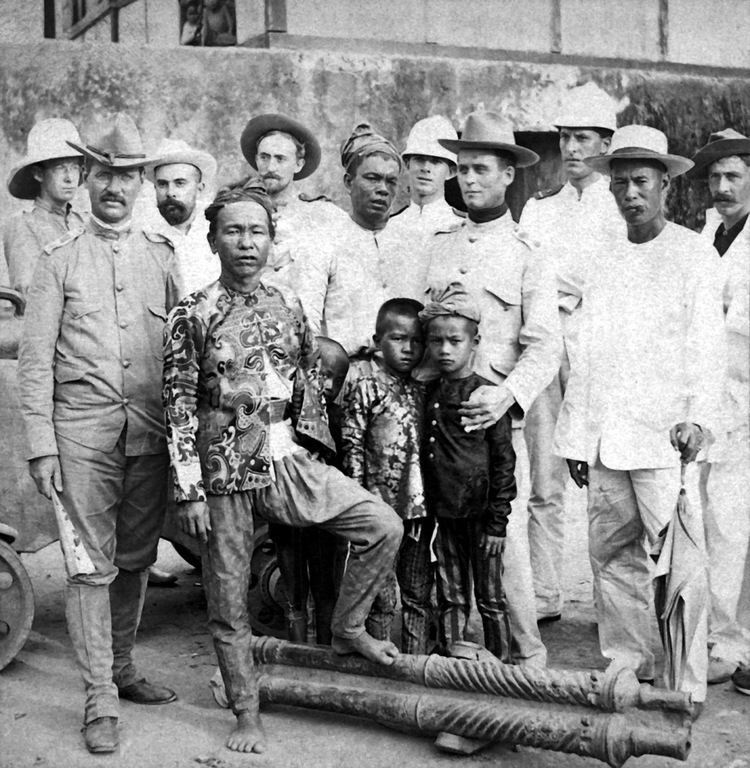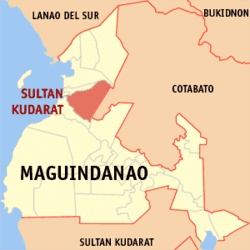Country | Area 712.91 km2 Mayor Shameem B. Mastura | |
 | ||
Region Autonomous Region in Muslim Mindanao | ||
Map of Sultan Kudarat, Maguindanao
Sultan Kudarat (formerly Nuling) is a 1st class municipality in the province of Maguindanao, Philippines.According to the 2015 census, it has a population of 95,201 people.
Contents
- Map of Sultan Kudarat Maguindanao
- Lebak sultan kudarat national highway from cotabato city via upi maguindanao
- The road projects of sultan kudarat maguindanao
- Barangays
- History
- Poverty incidence
- Education and Literacy
- Health
- Economy
- Farming
- Fishing
- Livestock and Poultry
- References

It currently serves as a de facto legislative capital of Maguindanao as it plays host to the Maguindanao Provincial Board, previously housed in the former capitol at Shariff Aguak. This restores its previous status as provincial capital, now shared with Buluan.
Lebak sultan kudarat national highway from cotabato city via upi maguindanao
The road projects of sultan kudarat maguindanao
Barangays
Sultan Kudarat is politically subdivided into 39 barangays.
History
Sultan Kudarat town was founded as a municipality by the name Nuling in August 18, 1947, by Executive Orver No. 82 signed by President Manuel Roxas. The town had its present name after it became the capital of the newly carved province of Maguindanao in 1975.
The town was part of the province of Shariff Kabunsuan from October 2006 until its nullification by the Supreme Court in July 2008.
The original seat of the Sultanate of Maguindanao was located at the mouth of the Maguindanao river (now Matampay) but later transferred to the nearby sitio at the bank of the Nuling Creek of Barangay Salimbao of this Municipality.
Sultan Mastura Kudarat, a royal lineage of the hero soldier Sultan Dipatuan Kudaratullah was appointed by American Governor Carpenter as President of the Municipal District of Nuling. The former, however, tactfully declined said and after and instead, designated his son, Datu Mamadra Mastura for the position, who served from 1922 to 1923. He was succeeded by the following executives:
Almost ten (10) years later, after the creation of the regular Municipality of Nuling on August 18, 1947, then President Carlos P. Garcia, aware on the development of the town, issued Executive Order No. 267 fixing the seat of the Municipal Government of Sultan Kudarat to Barangay Dalumangcob of the town.
In a plebiscite conducted on March 15, 2003, the electorates of this Municipality unanimously voted in favor of the creation of a new Municipality in the name of Sultan Mastura, being a son of Sultan Dipatuan Kudaratullah, better known as Sultan Kudarat. The New Municipality of Sultan Mastura has absorbed 13 barangays from the former leaving on 39 for its mother Municipality.
Presently, Sultan Kudarat has a total land area of 71,151 hectares and an unofficial Population Census Result of 152,667 and a 24,651 households as of August 1, 2007.
Poverty incidence
Presently, the LGU has a poverty incidence of 31.5% or there are about 57,147 of the 181,419 population who are living below the ARMM’s poverty threshold of 75,000 or an annual per capita income of P10,714 for the family size of 7. This poverty incidence is 1.4% lower than the National average of 32.9%.
Education and Literacy
About 79.2 percent of the municipality’s school age population are literate, that is able to read and write, based on the 1995 census. The data likewise shows that 43% are in elementary level and 26% are in high school level. College undergraduate shared with 5.4%, and 2.4% are college graduate.
Health
There is one (1) government hospital in the town, the Cotabato Sanitarium, but it caters only to specific health needs. There are about 26 Barangay Health Centers and 10 health personnel, composed of 1 medical doctor, 1 dental doctor, 6 midwives, 1 nurse and 1 sanitary inspector, serving the 39 barangays of the municipality. The health personnel are being augmented by 8 health workers and 39 trained hilots.
Economy
Though Sultan Kudarat hosts seventy percent of the agro-industries of the Province of Shariff Kabunsuan, its main economy is derived from the agriculture sector.
Farming
The municipality has 23,152.263 hectares of agricultural lands. While based on the year 2005 MAO’s report, only 10,035 hectares of which or forty percent (49%) have been productively used, reflecting a yield of 121.4, 13,282 and 7,820 metric tons for copra, rice and corn respectively, earning a gross income of P169,279,300.00 for the year 2005. Its High Value Commercial crops have so far covered 273 hectares and shared a total yield of 536 metric tons that earned P9, 357,000.00.
- Rice / 12,000 / 3.5 / Mostly upland rice
- Corn / 10,000 / 2.5
- Coconut intercropped with corn and other crops / 12,000 / 2 (for coconut) 2,5 (for other crops)
- Mango / 2,000 / 3
- Banana / 5,000 / 5
Fishing
The town possesses vast fishing grounds, the Maguindanao and Matampay Rivers, Illana Bay, lakes and its 1,393.4 hectares fishpond have been the major source of fish that supplies the fish requirements of the municipality and its neighboring towns. However, development programs have to be introduced to fully develop its potentials. The fish production reported is only 167,300 kilograms for the year 2005 which is not enough to supply the municipality’s fish requirement of 3.9 million kilograms.
Livestock and Poultry
In 2005, the Municipality of Sultan Kudarat has a total livestock population of 10,997 heads. The livestock species that are popularly raised in the municipality are carabao, cattle, and goat, probably because the town is thickly populated by the Islam believers. Its poultry population have totaled to 24,693 heads. The present livestock and poultry production of the municipality is not sufficient to supply the meat requirements of the municipality for it can only provide a total of 234,691 kilograms for the year 2005 which is very far behind the town’s food requirements of about 3.7 million kilograms.
Livestock / Number of Heads / Percent to Total
- Carabao / 3,120 / 17.4
- Cattle / 4,387 / 24.4
- Goat / 8,775 / 48.9
- Swine / 960 / 5.3
- Sheep / 136 / .75
- Horse / 53 / .29
- Others / 500 / 2.7
Livestock / Number of Heads / Percent (%) to Total
- Chicken / 31,287 / 36.1
- Ducks / 38,732 / 44.7
- Turkeys / 6,751 / 7.79
- Geese / 9,873 / 11.39
Source: DAF-ARMM, Sultan Kudarat, Maguindanao
